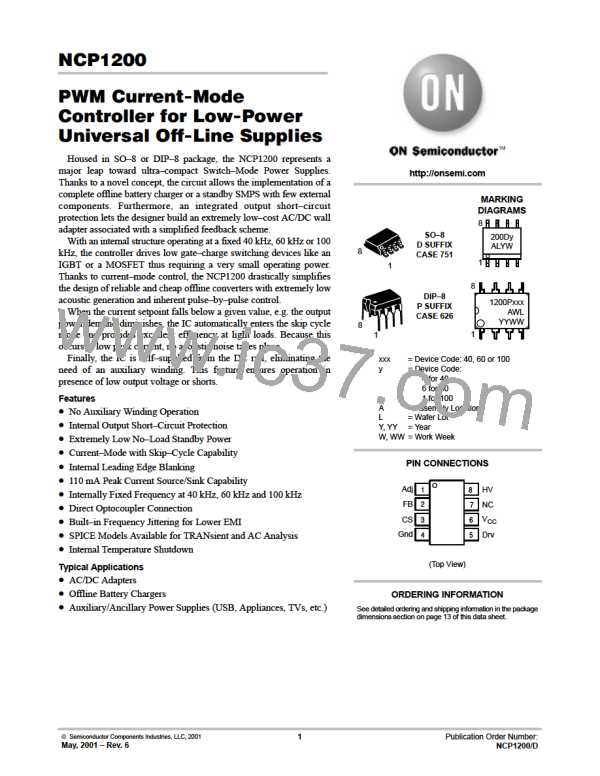NCP1200
Power Dissipation
Overload Operation
The NCP1200 is directly supplied from the DC rail
through the internal DSS circuitry. The current flowing
through the DSS is therefore the direct image of the
NCP1200 current consumption. The total power dissipation
can be evaluated using: (VHVDC * 11 V) @ ICC2. If we
operate the device on a 250 VAC rail, the maximum rectified
voltage can go up to 350 VDC. As a result, the worse case
dissipation occurs on the 100 kHz version which will
dissipate 340 . 1.8 mA@Tj = –25°C = 612 mW (however
this 1.8 mA number will drop at higher operating
In applications where the output current is purposely not
controlled (e.g. wall adapters delivering raw DC level), it is
interesting to implement a true short–circuit protection. A
short–circuit actually forces the output voltage to be at a low
level, preventing a bias current to circulate in the
optocoupler LED. As a result, the FB pin level is pulled up
to 4.1 V, as internally imposed by the IC. The peak current
setpoint goes to the maximum and the supply delivers a
rather high power with all the associated effects. Please note
that this can also happen in case of feedback loss, e.g. a
broken optocoupler. To account for this situation, the
NCP1200 hosts a dedicated overload detection circuitry.
Once activated, this circuitry imposes to deliver pulses in a
burst manner with a low duty–cycle. The system recovers
when the fault condition disappears.
temperatures).
A
DIP8
package
offers
a
junction–to–ambient thermal resistance of R
100°C/W.
qJ–A
The maximum power dissipation can thus be computed
knowing the maximum operating ambient temperature (e.g.
70°C) together with the maximum allowable junction
During the start–up phase, the peak current is pushed to
the maximum until the output voltage reaches its target and
the feedback loop takes over. This period of time depends on
normal output load conditions and the maximum peak
current allowed by the system. The time–out used by this IC
T
Jmax * TAmax
temperature (125°C): Pmax +
= 550 mW.
RRqJ*A
As we can see, we do not reach the worse consumption
budget imposed by the 100 kHz version. Two solutions exist
to cure this trouble. The first one consists in adding some
works with the V decoupling capacitor: as soon as the
copper area around the NCP1200 DIP8 footprint. By adding
CC
2
V
CC
decreases from the V
level (typically 11.4 V) the
a min–pad area of 80 mm of 35 m copper (1 oz.) R
drops
CCOFF
qJ–A
device internally watches for an overload current situation.
If this condition is still present when V is reached, the
to about 75°C/W which allows the use of the 100 kHz
version. The other solutions are:
CCON
controller stops the driving pulses, prevents the self–supply
current source to restart and puts all the circuitry in standby,
1. Add a series diode with pin 8 (as suggested in the
above lines) to drop the maximum input voltage
down to 222 V ((2 350)/pi) and thus dissipate
less than 400 mW
2. Implement a self–supply through an auxiliary
winding to permanently disconnect the self–supply.
consuming as little as 350 µA typical (I
parameter). As
CC3
a result, the V level slowly discharges toward 0. When
CC
this level crosses 6.3 V typical, the controller enters a new
startup phase by turning the current source on: V rises
CC
toward 11.4 V and again delivers output pulses at the
SO–8 package offers a worse R
compared to that of
qJ–A
UVLO crossing point. If the fault condition has been
the DIP8 package: 178°C/W. Again, adding some copper
area around the PCB footprint will help decrease this
H
removed before UVLO approaches, then the IC continues
L
its normal operation. Otherwise, a new fault cycle takes
place. Figure 20 shows the evolution of the signals in
presence of a fault.
number: 12 mm x 12 mm to drop R
down to 100°C/W
qJ–A
with 35 m copper thickness (1 oz.) or 6.5 mm x 6.5 mm with
70 m copper thickness (2 oz.). As one can see, we do not
recommend using the SO–8 package for the 100 kHz version
with DSS active as the IC may not be able to sustain the
power (except if you have the adequate place on your PCB).
However, using the solution of the series diode or the
self–supply through the auxiliary winding does not cause
any problem with this frequency version. These options are
thoroughly described in the AND8023/D.
http://onsemi.com
9

 ETC [ ETC ]
ETC [ ETC ]